超声波辅助正向渗透工艺:甜菜根汁浓缩的比较研究
IF 3.8
2区 物理与天体物理
Q1 ACOUSTICS
引用次数: 0
摘要
内浓度极化(ICP)在正向渗透(FO)浓缩过程中提出了重大挑战,因为它导致穿过膜的跨膜通量显著减少。减轻ICP是困难的,因为这种现象发生在膜的多孔支撑层内,并且试图诱导湍流或改变流体动力条件通常是不成功的。研究了33 kHz超声对甜菜根(Beta vulgaris)汁浓度的影响。采用正向渗透(FO)和超声辅助正向渗透(USFO)对甜菜根汁(5°Brix)进行浓缩(~ 61°Brix)。研究过程采用两种不同的超声应用组合,每10分钟超声5分钟关闭(USFO 10:5)和每5分钟超声10分钟关闭(USFO 5:10)。结果表明,超声处理能有效地部分缓解ICP效应,提高跨膜通量,使浓缩时间缩短2 h。此外,USFO 10:5比USFO 5:10更有效地缓解ICP过程。虽然提高了跨膜通量,但超声波导致盐通过膜进入进料溶液的反向渗透增加。此外,测定了USFO对甜菜根浓缩汁品质参数的影响,发现超声波对甜菜根浓缩汁的营养品质参数有影响,但对甜菜根浓缩汁的颜色参数影响不大。本文章由计算机程序翻译,如有差异,请以英文原文为准。

Ultrasonication assisted forward osmosis process: A comparative study on beetroot juice concentration
Internal concentration polarization (ICP) presents significant challenges in the forward osmosis (FO) concentration process, as it leads to a considerable reduction in transmembrane flux crossways the membrane. Mitigating ICP is difficult, as the phenomenon happens within the membrane’s porous support layer, and attempts to induce turbulence or alter hydrodynamic conditions are often unsuccessful. In the study, the inclusion of 33 kHz ultrasonication on FO beetroot (Beta vulgaris) juice concentration was investigated. The beetroot juice (5°Brix) was concentrated (∼61°Brix) using forward osmosis (FO) and ultrasonication assisted forward osmosis (USFO). The study process utilizes two different ultrasonication application combination with every 10 min ultrasonication with 5 min off (USFO 10:5) and with every 5 min ultrasonication with 10 min off (USFO 5:10). The results indicate that the applied ultrasonication effectively partially mitigated the ICP effect, enhancing transmembrane flux and reducing concentration time by 2 h. It was also observed that USFO 10:5 was more effective in mitigation of ICP process compared to USFO 5:10. Although transmembrane flux was improved, ultrasonication led to an increased reverse draw salt permeation across the membrane into the feed solution. Additionally, the effect of USFO on the quality parameters of beetroot juice concentrates was measured, and it was found that ultrasonication has affected the nutritional quality parameters, but the color parameters were not much effected.
求助全文
通过发布文献求助,成功后即可免费获取论文全文。
去求助
来源期刊

Ultrasonics
医学-核医学
CiteScore
7.60
自引率
19.00%
发文量
186
审稿时长
3.9 months
期刊介绍:
Ultrasonics is the only internationally established journal which covers the entire field of ultrasound research and technology and all its many applications. Ultrasonics contains a variety of sections to keep readers fully informed and up-to-date on the whole spectrum of research and development throughout the world. Ultrasonics publishes papers of exceptional quality and of relevance to both academia and industry. Manuscripts in which ultrasonics is a central issue and not simply an incidental tool or minor issue, are welcomed.
As well as top quality original research papers and review articles by world renowned experts, Ultrasonics also regularly features short communications, a calendar of forthcoming events and special issues dedicated to topical subjects.
 求助内容:
求助内容: 应助结果提醒方式:
应助结果提醒方式:


